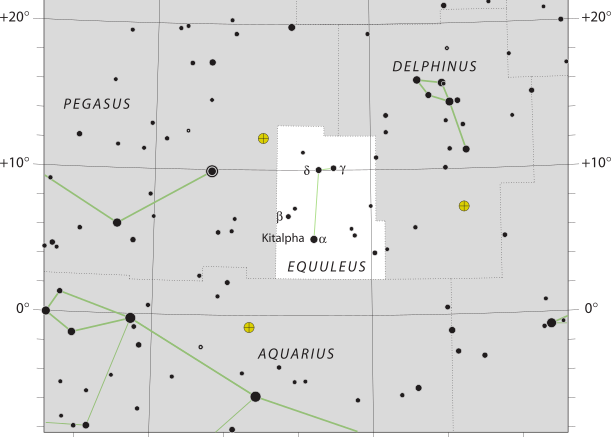The constellation Equuleus, which is Latin for “little horse” is shaped as a foal. The constellation is the 87th largest constellation, which makes it the 2nd smallest constellation in the sky. Equuleus spans 72 degrees in the sky, with only Crux being smaller. There are no stars in the constellation that are brighter than 4th magnitude.
It was one of the 48 constellations listed by the 2nd century astronomer Ptolemy, and remains one of the 88 modern constellations.
| Applicable Information | |
| Visibility In Pacific Northwest | May to December |
| Best Times To View | September |
| Right Ascension | 21h |
| Declination | +10° |
| Area | 72 square degrees |
| Main Stars | 3 |
| Brightest Object | α Equ, Kitalpha |
| Meteor showers | 0 |
| Messier objects | 0 |
| Neighboring Constellations | Aquarius, Delphinus, Pegasus |
Mythology
In Greek mythology, there is a myth that associates Equuleus with the foal Celeris. There are other myths that links Equuleus to the story of Philyra and Saturn. The constellation was created by Hipparchus and included by Ptolemy.
In Chinese astronomy, the stars in the Equuleus constellation are located within the Black Tortoise of the North
Stars
The brightest star in the constellation is Alpha Equulei, which is a yellow star of magnitude 3.9. It has a traditional name meaning “the section of the horse.”
There have been 25 variable stars discovered in Equuleus, but most of these variable stars are faint. There are also some double stars in the constellation.
Due to its small size and its distance from the plane of the Milky Way, Equuleus contains no notable deep sky objects. There are very faint galaxies that have been observed which have magnitudes between 13 and 15, which include NGC 7015, NGC 7040, NGC 7045 and NGC 7046.
Make sure to check out other articles on the site, including a brief introduction to constellations, other constellation articles, and more!

Be the first to comment on "Equuleus"